Related Research Articles

Ray Douglas Bradbury was an American author and screenwriter. One of the most celebrated 20th-century American writers, he worked in a variety of genres, including fantasy, science fiction, horror, mystery, and realistic fiction.
The butterfly effect is a metaphor for sensitive dependence on initial conditions in chaos theory.
Dinosaurs constitute a group of animals of the clade Dinosauria.

A Sound of Thunder is a 2005 American science fiction thriller film directed by Peter Hyams and starring Edward Burns, Catherine McCormack and Ben Kingsley. It is a co-production film between the United Kingdom, the United States, Germany, and the Czech Republic.

The Bradbury Building is an architectural landmark in downtown Los Angeles, California, United States. Built in 1893, the five-story office building is best known for its extraordinary skylit atrium of access walkways, stairs and elevators, and their ornate ironwork. The building was commissioned by Los Angeles gold-mining millionaire Lewis L. Bradbury and constructed by draftsman George Wyman from the original design by Sumner Hunt. It appears in numerous works of fiction and has been the site of many movie and television shoots and music videos.
"The Fog Horn" is a 1951 science fiction short story by American writer Ray Bradbury, the first in his collection The Golden Apples of the Sun. The story was the basis for the 1953 action horror film The Beast from 20,000 Fathoms.

"Treehouse of Horror V" is the sixth episode of the sixth season of the American animated television series The Simpsons, and the fifth entry in the Treehouse of Horror series. It originally aired on the Fox network in the United States on October 30, 1994, and features three short stories: "The Shinning", "Time and Punishment", and "Nightmare Cafeteria".
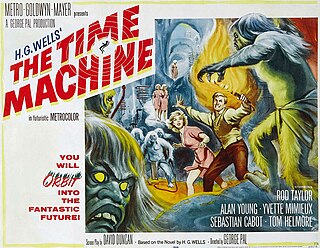
Time travel is a common theme in fiction, mainly since the late 19th century, and has been depicted in a variety of media, such as literature, television, film, and advertisements.

Dinosaurus! is a 1960 science fiction film directed by Irvin Yeaworth and produced by Jack H. Harris.

The Stories of Ray Bradbury is an anthology containing 100 short stories by American writer Ray Bradbury, first published by Knopf in 1980. The hundred stories, written from 1943 to 1980, were selected by the author himself. Bradbury's work had previously been collected in various compilations, such as The Martian Chronicles and The October Country, but never in such a large volume or spanning such a long period of time.

Tyrannosaurus rex is unique among dinosaurs in its place in modern culture; paleontologist Robert Bakker has called it "the most popular dinosaur among people of all ages, all cultures, and all nationalities". Paleontologists Mark Norell and Lowell Dingus have likewise called it "the most famous dinosaur of all times." Paleoartist Gregory S. Paul has called it "the theropod. [...] This is the public's favorite dinosaur [...] Even the formations it is found in have fantastic names like Hell Creek and Lance." Other paleontologists agree with that and note that whenever a museum erects a new skeleton or bring in an animatronic model, visitor numbers go up. "Jurassic Park and King Kong would not have been the same without it." In the public mind, T. rex sets the standard of what a dinosaur should be. Science writer Riley Black similarly states, "In all of prehistory, there is no animal that commands our attention quite like Tyrannosaurus rex, the king of the tyrant lizards. Since the time this dinosaur was officially named in 1905, the enormous carnivore has stood as the ultimate dinosaur."

Rivers of Time is a 1993 collection of science fiction short stories by American writer L. Sprague de Camp, first published in paperback by Baen Books. All but one of the pieces were originally published between 1956 and 1993 in the magazines Galaxy, Expanse, The Magazine of Fantasy & Science Fiction, Analog, and Asimov's Science Fiction, and the Robert Silverberg-edited anthology The Ultimate Dinosaur. The remaining story was first published in the present work.

Years in the Making: the Time-Travel Stories of L. Sprague de Camp is a collection of science fiction stories by American author L. Sprague de Camp, edited by Mark L. Olson and illustrated by Bob Eggleton. It was first published in hardcover by NESFA Press in February 2005, with a NESFA/Science Fiction Book Club edition following in September of the same year.

The Rhedosaurus is a fictional dinosaur that debuted in the 1953 monster film The Beast from 20,000 Fathoms, directed and co-written by Eugène Lourié. The Rhedosaurus is depicted as a giant, destructive, prehistoric reptile that is immune to most modern artillery in its major on-screen appearance, and would later appear in the 1977 science fiction film Planet of Dinosaurs.

A Sound of Thunder is a 2004 video game for the Game Boy Advance. The game was developed by Möbius Entertainment and published by BAM! Entertainment. It was released in Europe on February 28, 2004 before arriving in North America on February 1, 2005. The story is based loosely both on the original short story by Ray Bradbury of the same name and follows more closely the plot of the 2005 film.
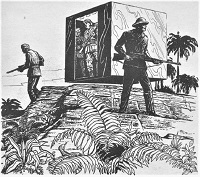
"A Gun for Dinosaur" is a classic time travel science fiction story by American writer L. Sprague de Camp as part of his Rivers of Time series. It tells the story of four men who travel into the past to hunt dinosaurs.
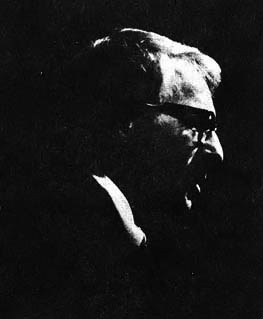
The following is a list of works by Ray Bradbury.
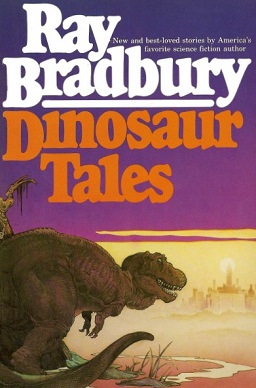
Dinosaur Tales is a 1983 short story collection by Ray Bradbury. Several of the stories are original to this collection. Other stories were first published in Collier's and The Saturday Evening Post magazines. The collection contains over 60 pages of illustrations by Gahan Wilson, William Stout, Steranko, Moebius, Overton Loyd, Kenneth Smith and David Wiesner.
The butterfly effect describes a phenomenon in chaos theory whereby a minor change in circumstances can cause a large change in outcome. The scientific concept is attributed to Edward Lorenz, a mathematician and meteorologist who used the metaphor to describe his research findings related to chaos theory and weather prediction, initially in a 1972 paper titled "Predictability: Does the Flap of a Butterfly's Wings in Brazil Set Off a Tornado in Texas?" The butterfly metaphor is attributed to the 1952 Ray Bradbury short story "A Sound of Thunder".
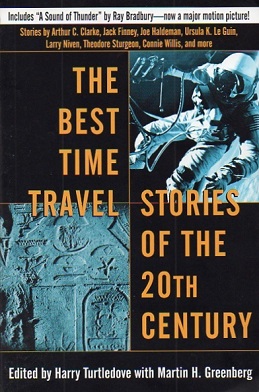
The Best Time Travel Stories of the 20th Century is an anthology of science fiction time travel short stories edited by Harry Turtledove and Martin H. Greenberg. It was first published in trade paperback by Del Rey/Ballantine in January 2005. The book has been translated into Portuguese.
References
- ↑ Birx, H. James (January 13, 2009). Encyclopedia of Time: Science, Philosophy, Theology, & Culture. Sage Publications. pp. 109–. ISBN 9781412941648 . Retrieved November 22, 2015.
- ↑ "Weird Science-Fantasy #3". Grand Comics Database. Retrieved February 4, 2019.
- ↑ "Ray Bradbury Comics #1". TV.com. May 22, 2007. Retrieved October 5, 2013.
- ↑ "The Ray Bradbury Theater — Season 4, Episode 6: A Sound of Thunder". TV.com. Archived from the original on November 6, 2016. Retrieved February 4, 2019.
- 1 2 Ebert, Roger (February 5, 2013). Roger Ebert's Movie Yearbook 2007. Andrews McMeel Publishing. pp. 648–. ISBN 9780740792199 . Retrieved November 22, 2015.
- ↑ "A Sound of Thunder". ca.ign.com. IGN. March 2, 2005. Retrieved October 5, 2013.
- ↑ Rogers, Brett M.; Stevens, Benjamin Eldon (February 9, 2015). Classical Traditions in Science Fiction. Oxford University Press. p. 322. ISBN 9780190228330 . Retrieved November 22, 2015.
- ↑ Flam, Faye (June 15, 2012). "The Physics of Ray Bradbury's 'A Sound of Thunder'". The Philadelphia Inquirer . Retrieved September 2, 2015.